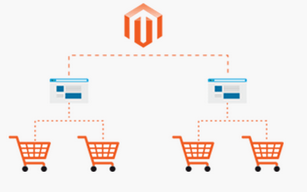
Running an e-commerce store takes time, work and money. The task becomes even greater when it is necessary to manage several stores. With the multisite functionality, the Magento platform facilitates the management of several stores. Thanks to its powerful features, you will be able to customize a single Magento installation to suit the specific needs of your store.
Structure of the Magento multisite
Whether you need to create or manage multiple stores, including similar stores with different currencies or languages to serve multiple regions; different stores sharing the same customer base; completely separate shops while centralizing their management, whatever the desired goal, the hierarchical structure of the Magento multisite gives a variety of possibilities aimed at meeting the needs of the shops as much as possible with a single installation of Magento.
- The Magento multisite (website). This is the first level of a Magento instance. It is therefore at this level that the general parameters of a store such as payment and shipping methods are configured. Likewise, it is at this level that the separation into different website (shop) takes place. It is important to note that you can share customer accounts between multiple sites on the same Magento instance.
- The Magento multistore (shop). Contained in a multisite, this is your store’s catalog. As a result, we can structure and organize the products and categories at this level. If you sell DIY tools, for example, you can make two different blinds for gardening and decorating.
- The multistore view (visual). This level relates to how your store looks to a target audience. It therefore makes it possible to define the language, the design of the store, the currencies and others.
A Magento store must have at least one site, one store and one store view.
Why you need to use a Magento multisite
A Magento multisite offers many advantages making it easy to manage your e-commerce project.
- It makes it easy for visitors to navigate your site and improves the user experience. As a result, visitors stay on your site longer, increasing your store’s SEO. Who says better SEO, says more visitors, therefore more yield.
- The benefit of this structure doesn’t just affect your visitors, but you too. In fact, the management of the multisite is done from a single control panel. Whether you have to change the theme, configure extensions or the settings of your sites and stores, everything happens from a single interface.
- Likewise, you won’t have difficulty managing your clients’ accounts. Additionally, you can provide different payment and shipping methods to different regions to boost your business.
- In addition, the expansion of the store is happening very quickly.
Magento Multisite prerequisites
To be able to make the most of the advantages of a Magento multisite, make sure you have:
- A powerful and efficient web hosting. As we have seen above a multisite is often the business / is required by medium and large stores, which means a high traffic, therefore a heavy load. Aside from traffic, a multisite (or multistore) goes with double resources. This is why we recommend at least a VPS Cloud server and ideally a dedicated server for the best operation of your store.
- A Wildcard multi-domain SSL certificate. For the needs of your multistore, you may use several domain names or subdomains. Due to the structure of a Magento multisite, it is not possible to use several different SSL certificates for a single installation. Some web hosts in the market offer hosting plans with such an SSL certificate included for free.